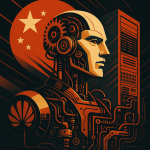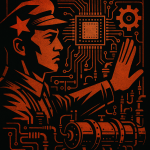Key Points
- China’s MIIT Minister, Li Lecheng (李乐成), is spearheading “new industrialization” through AI, aiming to make factories and supply chains more high-end, intelligent, and green.
- Shanghai is focused on AI foundational layers, fostering innovation, growing high-quality AI enterprises, and strengthening global partnerships (e.g., BRICS AI center).
- Beijing emphasizes enterprise-led AI growth, with visits to key players like Cambricon (寒武纪) for AI chips and BOE Technology (京东方) for industrial application.
- The MIIT’s 5-point AI action plan includes strengthening core foundations (computing power, algorithms, data), pinpointing real-world applications, and a significant bet on humanoid robots.
- A crucial aspect of China’s strategy is to balance AI development with security by establishing a full-lifecycle security mechanism.

China’s AI strategy is getting a major push from the top, and the latest directives give us a clear look at the game plan.
Li Lecheng (Li Lecheng 李乐成), the head of China’s Ministry of Industry and Information Technology (MIIT), just wrapped up a high-profile tour of AI hotspots in Shanghai and Beijing.
The mission? To supercharge China’s push for “new industrialization.”
Think of it as Industry 4.0 with Chinese characteristics: using Artificial Intelligence to make every factory and supply chain more high-end, intelligent, and green.
This isn’t just a vague goal; it’s a coordinated effort to implement directives straight from General Secretary Xi Jinping and the State Council.
Here’s a breakdown of what went down and what it means for the future of tech.
Shanghai: The Hub for AI Innovation and Global Collabs
In Shanghai, the focus was squarely on building the foundational layers for AI dominance.
Minister Li didn’t just visit any old offices. His tour included a who’s-who of strategic AI centers:
- The National and Local Co-built Humanoid Robot Innovation Center
- “Model Speed Space” (Mo Su Kong Jian 模速空间) – an innovation community specifically for large model development.
- The China-BRICS Artificial Intelligence Development and Cooperation Center
- The world-renowned Shanghai AI Laboratory
The message from these visits was crystal clear.
China is betting on an “all hands on deck” approach by uniting industry, academia, and research.
The key takeaways from the Shanghai leg of the tour were:
- Drive Innovation: Double down on R&D and push for serious technological breakthroughs.
- Grow Winning Companies: Incubate and cultivate a new generation of high-quality AI enterprises.
- Collaborate Globally: Strengthen international partnerships, especially with initiatives like the BRICS AI center, to make sure AI benefits everyone and contributes “Chinese wisdom” to the world.

Resume Captain
Your AI Career Toolkit:
- AI Resume Optimization
- Custom Cover Letters
- LinkedIn Profile Boost
- Interview Question Prep
- Salary Negotiation Agent

Beijing: Where AI Gets Real with Enterprise-Led Growth
If Shanghai was about building the foundation, Beijing was all about putting it to work.
The focus here shifted to the companies on the front lines, turning AI theory into commercial reality.
Li’s meetings included some of the most important names in China’s tech scene:
- Cambricon (Han Wu Ji 寒武纪): A key player in China’s mission to develop high-performance, homegrown AI chips—a crucial piece of the puzzle amid global tech tensions.
- Speechocean (Hai Tian Rui Sheng 海天瑞声): A reminder that high-quality data is the fuel for any AI model. This visit signals a focus on building robust, proprietary datasets.
- BOE Technology (Jing Dong Fang 京东方): A manufacturing giant, demonstrating the direct application of AI in upgrading massive industrial operations.
- National and Local Co-built Embodied AI Robot Innovation Center: Highlighting the push towards physical, “embodied” AI.
- Longwood Valley (Chang Mu Gu 长木谷): An innovative MedTech company using AI for orthopedic surgery, a perfect example of AI’s deep, vertical applications.
The directive for these enterprises is simple: lead the charge.
Companies are expected to not only meet market demand but also to actively shape the industry by participating in creating new standards and best practices.

The MIIT’s 5-Point AI Action Plan
So, what’s the actual playbook? Li Lecheng laid out a powerful, five-part strategy to fast-track the development of China’s AI industry.
This is the roadmap investors, founders, and competitors should be watching.
1. Strengthen the Core Foundation
It all starts with the “holy trinity” of AI:
- Computing Power: Building and securing the hardware needed to train massive models.
- Algorithms: Developing smarter, more efficient AI models.
- Data Supply: Creating and managing high-quality datasets to power it all.
2. Pinpoint Real-World Applications
This isn’t about research for the sake of research. The mandate is to find mature, scalable AI solutions for key industries:
- Equipment Manufacturing
- Electronic Information
- Raw Materials
- Consumer Goods
The goal is to deeply integrate large models across the entire manufacturing process.
3. Go Big on Intelligent Terminals (aka Humanoid Robots)
China is making a serious bet on humanoid robots as the next major tech platform.
The plan is to accelerate their development by focusing on:
- Common Technology R&D: Solving the core challenges to make robots more capable.
- Foundational Data: Building the massive datasets needed to train these robots.
- Creating Standards: A strategic move to define the rules for data collection, cleaning, labeling, and product testing—a way to build a powerful moat around their ecosystem.
4. Build a Thriving Ecosystem
No industry can succeed in a vacuum.
The government plans to foster growth by promoting high-level AI open-source communities and strategically deploying capital through national AI industry investment funds.
5. Balance Development with Security
China is keenly aware of the risks that come with powerful AI.
A key directive is to innovate AI security governance and establish a full-lifecycle security mechanism to monitor and manage risks from development to deployment.
- 1. Core Foundation: Computing power, algorithms, data supply.
- 2. Real-World Applications: Integration across key industries (manufacturing, electronics, raw materials, consumer goods).
- 3. Intelligent Terminals: Accelerate humanoid robot development (R&D, data, standards).
- 4. Thriving Ecosystem: Promote open-source, deploy national investment funds.
- 5. Security Balance: Innovate AI security governance, establish full-lifecycle security.
This isn’t just a high-level plan; it’s a clear roadmap for where China is placing its bets in the global AI race.
For founders, investors, and tech leaders, the message is clear: China’s AI-powered new industrialization is officially in overdrive.

Find Top Talent on China's Leading Networks
- Post Across China's Job Sites from $299 / role, or
- Hire Our Recruiting Pros from $799 / role
- Qualified Candidate Bundles
- Lower Hiring Costs by 80%+
- Expert Team Since 2014
Your First Job Post






